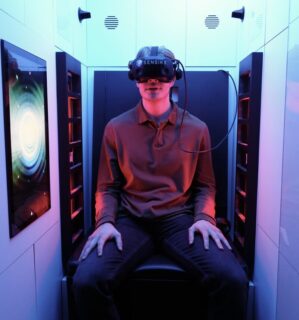The COVID pandemic accelerated the use of technology in the virtual and digital platforms by individuals for a whole host of unique systems, which effectively helped to improve the value and quality of life for many.
Virtual medical-doctor appointments through video or phone consultations, for example, give healthcare professionals and patients access to more knowledge and expertise in a hassle-free and convenient way. Digital medical records are more accessible to patients now, too, and being able to view test results online enables individuals to request specific prescriptions more easily, saving time and effort.
Healthspan is the future and technology is the aid
On a more futuristic level, healthcare companies are using drones to access remote areas for the delivery of vaccines and other important medication.
Moreover, on the wellness side of things, there’s significant development that can improve productivity, while enabling accurate tracking of elements such as fitness, nutrition and sleep on a continuum.
According to Dr. Ron Whelan, CEO of Discovery Health, the role of smartwatches and wearables is becoming very important in healthcare, and the personalization of healthcare.
Smartwatches and wearables are becoming incredibly sophisticated and precise in tracking a range of personal health metrics. Big tech companies such as Apple and Samsung are making significant investments in the tracking of a range of health metrics.
Wearables are evolving fast
These devices already track heart rate, heart-rate variability, sleep, stress, physical activity and oxygen saturation. New-age wearables will be able to track many more metrics, including blood pressure, blood glucose and so on.
“Apple is already building a sensor that will monitor blood-glucose levels. This will likely move into cholesterol monitoring over time. Meanwhile, Samsung recently launched the Samsung Galaxy Ring, with similar intended functionality. The sophistication of the sensors and underlying technology built into a simple wristwatch is truly remarkable and will revolutionize personal healthcare into the future.”
What this allows us to do is extract continuous data that we’ve never had before.
“In a world of machine learning and artificial intelligence, which allows us to see patterns across large healthcare datasets, we’re on the brink of discovering things that we never imagined about our own health and about population health. And then, when you combine those large healthcare datasets with some level of genetic or genomic data, the insights become even more precise and personalized, potentially unlocking radical advances in longevity and healthspan.”
The future is AI
The use of AI in wellness and medicine is starting to look more and more like the Jetsons’ Orbit City.
And it’s one part of the future expansion plans of the InuVersal group. Dr Kathleen Green, product manager of the group, says that there are multiple ways in which AI will benefit users in healthcare. “[First], there’s the benefits to the individual, such as personalized data insights from wearables, faster and more convenient access to expertise through telemedicine, and improved risk prevention, to name just a few.
“On the other hand, there are the benefits that technology brings to providers and institutions within the healthcare system. For example, hospitals are becoming smart hospitals, meaning they’re becoming more efficient by embedding new technologies to improve the patient experience, health outcomes, and reduce costs. Also, by connecting these various systems to a central ecosystem, administrative overhead is reduced, and practitioners have a much better view of the entire patient journey, from start to finish. As more data is collected and centralized, better mathematical models can be built for an individual, resulting in tailored health solutions.”
Virtual Reality is changing the way we experience health
Green believes surgeons using virtual reality (VR) headsets to do surgical planning and preparation will soon become much more common. “What they can do is phenomenal. With this technology, surgeons can see things in a dimension they haven’t seen before. For example, the 3D experience beforehand provides a better understanding of the anatomical structure of certain organs and how they may be affected. This allows surgeons to be more familiar with a case before an invasive surgery. This can result in the surgeon being faster and more accurate, and the patient spending less time in surgery, which is a risk reduction for both patient and doctor.”
Teaching with technology
AI also has tremendous benefits for students, particularly in the medical field.
“Teaching with technology is an important topic right now,” says Jeremy Richards, MD, chair of the Department of Medical Education at Mount Auburn Hospital in Massachusetts, US. “With the growing popularity of social platforms, virtual reality, simulation, blockchain technology and artificial intelligence, many medical educators have pressing questions about what these advances might mean for their future and how to leverage them most effectively.”
VR and AR can further be used to create a virtual operating room where students can practise “operating”, by using special tools that mimic the feel of live surgery. “Instead of practicing operating on a mannequin, as we did in the past, the VR experience can transfer that exposure into something that looks and feels like a real person. This is a much more immersive experience, and brings deeper value to the student,” Richards says.
Simulation is another mechanism that can be used in medical training. It involves using tools to create synthetic environments in which medical students can develop and hone their clinical skills. These simulated exercises are often recorded, enabling the instructor to review them with the students.
At the same time, there is continuous growth in online learning platforms, which makes education and development more accessible worldwide. We’re better able to stave off age-related mental decline through cognitive apps and games, and there are ever-growing audiobooks and digital reading apps to promote literacy and lifelong learning habits.
Our productivity has never had so much support, thanks to the continuous development of workflow software, cloud-based collaboration tools, scheduling apps and videoconferencing, which allow for more remote working options and the successful management of professional responsibilities.
Data sharing
CareConnect HIE (health information exchange) is a game-changing initiative in Africa set to connect providers, patients and funders through a unified care record that delivers up-to-date, real-time and consolidated information across the entire healthcare ecosystem. The brainchild of major hospital groups including Netcare, Life Healthcare and Mediclinic, along with leading medical-scheme administrators such as Discovery Health, Momentum Health and Medscheme, the interoperable health system not only aims to reduce medication and medical errors, and to facilitate standardization across practices and specialties, but it also works to reduce admin costs and paperwork. Furthermore, patients can be more involved in their healthcare.
Dr. Rolan Christian, CEO of CareConnect, explains that the HIE movement started in the US, where there was a drive to standardize the use of data within the healthcare sector.
“A key objective for us is to improve efficiencies and quality within our healthcare sector,” he says. “We always use the example of being able to reduce unnecessary duplicate testing, because, via the HIE, your treating doctor would be able to see what tests or scans you’ve already had. Ultimately, where we see the HIE in South Africa going is that we want to see an interoperable sector – both private and public. To have a health system where movement from one doctor to another, or from one facility to another, is seamless because the patient’s electronic health record is available wherever and whenever it’s needed, to deliver better patient care.“
Making fitness fun
Gamification is known to assist with boredom in tedious activities, and has considerable applications in exercise, particularly to keep people motivated and expand possibilities.
Dr. Kathleen Green believes it’s going to be a big thing in fitness. For example, in a rainy, cold winter, you can keep yourself motivated and meet your fitness goals by using modern technology VR headsets to transport yourself to a sunny location or somewhere you’ve always wanted to visit. InUversal’s InUWell retail center in Cape Town, which offers an AI-enabled wellness facility, now offers this option in its VR Gym.
For sports that aren’t always practical in a gym setting, such as kitesurfing, kayaking or rock climbing, VR can help to facilitate the experience. VR headsets can also be linked to other headsets in different parts of the world, so a user in Cape Town can sweat it out alongside a friend living in Singapore.
Try sensory reality
Users can also look forward to the health benefits of sensory reality. Sensory reality pods are available all over the world, from banks to airlines to government institutions.
Research has shown that these can have a considerable positive impact in the treatment of mental-health disorders such as PTSD, addictions and anxiety. They can also help reduce stress, prevent burnout, treat neonatal illnesses and muscular-skeletal disorders, and more.
 “Sensory reality allows for a range of multisensory real-life and fantasy-based experiences to be replicated in superb detail, with the body’s five senses activated simultaneously,” explains Fred Galstaun, director of Sensiks, a Netherlands developer of sensory reality pods. “Multisensory digitization of experiences will help to ‘bridge the gap’ between reality and simulation,” he says.
“Sensory reality allows for a range of multisensory real-life and fantasy-based experiences to be replicated in superb detail, with the body’s five senses activated simultaneously,” explains Fred Galstaun, director of Sensiks, a Netherlands developer of sensory reality pods. “Multisensory digitization of experiences will help to ‘bridge the gap’ between reality and simulation,” he says.
“The metaverse will change the way humans live, work, play, socialize, travel, heal, shop and entertain themselves. Developments in multisensory metaverse technology will also bring profound discoveries in the field of neuroscience, unlocking new, exciting capabilities of the human brain.
“What computer programming did for the digitization of society and the economy in recent decades is what sensory reality will do for understanding and optimizing the mental states of human beings,” Galstaun says.
Kick your smartphone addiction
Screen addiction is leading to a wide array of physical and physiological problems, such as muscle strain, eye strain, sleep disturbances, social isolation, anxiety and depression.
Now, an AI startup based in the US, called Humane – founded by two former Apple designers, Imran Chaudhri and Bethany Bongiorno – has created a gadget called the Ai Pin. This new take on wearable devices is worn on the lapel and provides functions such as voice-operated calls, messages and data retrieval through voice controls. It also boasts a laser-projection system that transforms your hand into a miniature screen. The screen can display the time, date and what’s nearby.
Because its focus is to fade into the background of everyday life and not get users distracted, or blitzed with dopamine every 10 minutes through texts, hearts, emails, likes or other notifications, it helps users to be more productive, and prevents them from losing time scrolling.
“There are no wake words, so it’s not always listening or always recording. In fact, it doesn’t do anything until you engage with it, and your engagement comes through your voice, touch, gesture or the laser ink display,” Chaudhri says. “We don’t do apps,” Bongiorno adds. “Humane’s OS runs AI experiences that are on device and in the cloud. The OS understands what you need and picks the right AI for the moment.”
The device’s assistant can also summarize the user’s daily calendar, the messages received, or health data, such as the amount of “protein I had today”.
At the same time, the mobile operating systems provided by Google and Apple both offer complimentary tools that can effectively control screen time on smartphones and tablets. These tools enable parents to supervise and establish restrictions on their children’s devices.
For Android devices, there’s Family Link, an app that must be downloaded through the Google Play Store. From there, parents can set up a child’s Google account to be monitored with the software. There is also a Family Link app for iOS.
The ethics of modern technology
On the one hand, it’s exciting to see humanity taking leaps, through modern technology and AI, and the acceleration of the last few years is arguably sending us lightyears into the future. But for many, this rapid acceleration isn’t sitting too comfortably.
In March 2023, an open letter called for all AI labs to immediately pause, for at least six months, the training of AI systems more powerful than GPT-4. It made the statement that we should be developing powerful AI technology systems only once we’re confident their effects will be positive and their risks manageable.
The letter also cited OpenAI’s recent statement on artificial intelligence: “At some point, it may be important to get independent review before starting to train future systems, and for the most advanced efforts to agree to limit the rate of growth of compute used to create new models.”
As we know, there is no pause to any AI development and any warnings appear to be going unheard or unrestrained.
Aligning AI with human competitive intelligence
Eliezer Yudkowsky is a decision theorist who leads research at the Machine Intelligence Research Institute in the US. He’s been working on aligning Artificial General Intelligence since 2001 and is widely regarded as a founder of the field.
In an article for Time, Yudkowsky suggests the key issue is not “human-competitive” intelligence; it’s what happens after AI gets to smarter-than-human intelligence.
“Key thresholds there may not be obvious; we definitely can’t calculate in advance what happens when, and it currently seems imaginable that a research lab could cross critical lines without noticing. Many researchers steeped in these issues, including myself, expect that the most likely result of building a superhumanly smart AI, under anything remotely like the current circumstances, is that literally everyone on Earth will die. Not as in ‘maybe possibly some remote chance’, but as in ‘that is the obvious thing that would happen’. It’s not that you couldn’t, in principle, survive creating something much smarter than you; it’s that it would require precision and preparation and new scientific insights, and probably not having AI systems composed of giant inscrutable arrays of fractional numbers.”
The downside of technology
According to Yudkowsky, should humanity have to face down an opposing superhuman intelligence at some point, the likely result will be a total loss.
“To visualize a hostile superhuman AI, don’t imagine a lifeless book-smart thinker dwelling inside the internet and sending ill-intentioned emails. Visualize an entire alien civilization, thinking at millions of times human speeds, initially confined to computers – in a world of creatures that are, from its perspective, very stupid and very slow. A sufficiently intelligent AI won’t stay confined to computers for long. In today’s world, you can email DNA strings to laboratories that will produce proteins on demand, allowing an AI initially confined to the internet to build artificial life forms or bootstrap straight to post-biological molecular manufacturing.”
A collective responsibility in modern technology
The landscape of data privacy and AI regulation in technology is evolving all over the world. Even as I write this information becomes dated.
Governments, regional bodies and international organizations are increasingly recognizing the importance of addressing these issues, so there may be ongoing efforts to establish more comprehensive policies and units focused on data privacy and AI.
Overall, a collaborative effort involving government agencies, regulatory bodies, industry stakeholders, advocacy groups and researchers is essential for effectively monitoring AI privacy and safeguarding people’s rights in an increasingly AI-driven world.
The bottom line
As much as we can believe that AI is the responsibility of companies or governments, the reality is that we all, in our respective capacities, hold responsibility to influence a world where artificial intelligence technology roams.
References and important note
This article was first published in Longevity’s annual bookazine 2024-2025 on shelf August 2024. Hence some of the content in this article will not include developments in technology from August 2024 to February 2025. As technology and specifically the world of AI is moving at a rapid rate, the context and timing of the article must be noted.
Buy the magazine
You can buy a digital copy of the magazine here.



![women [longevity live]](https://longevitylive.com/wp-content/uploads/2020/01/photo-of-women-walking-down-the-street-1116984-100x100.jpg)










